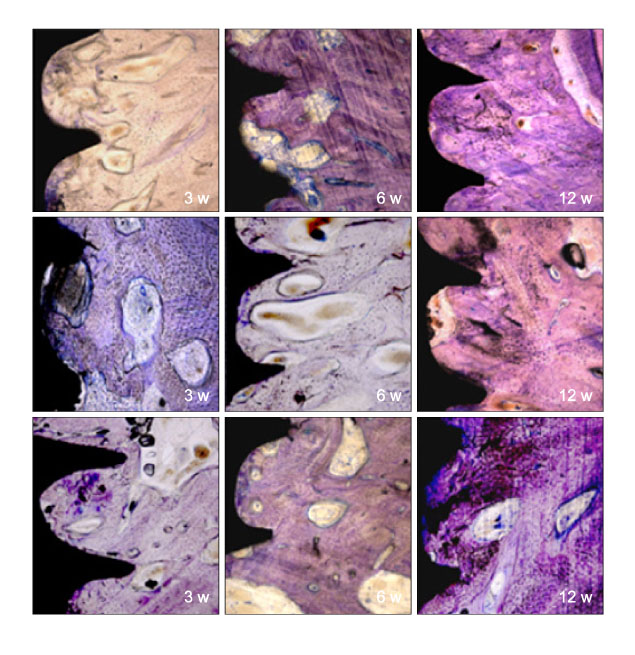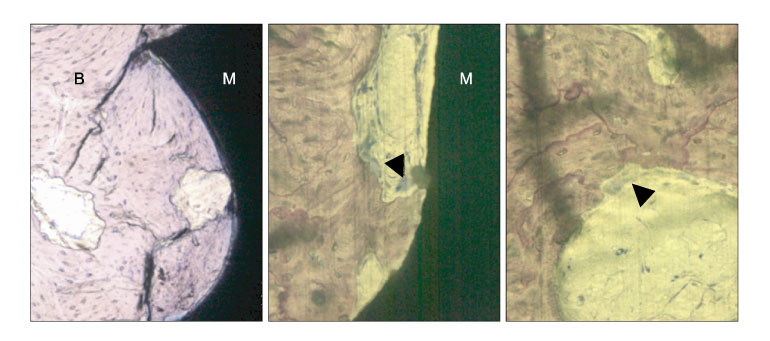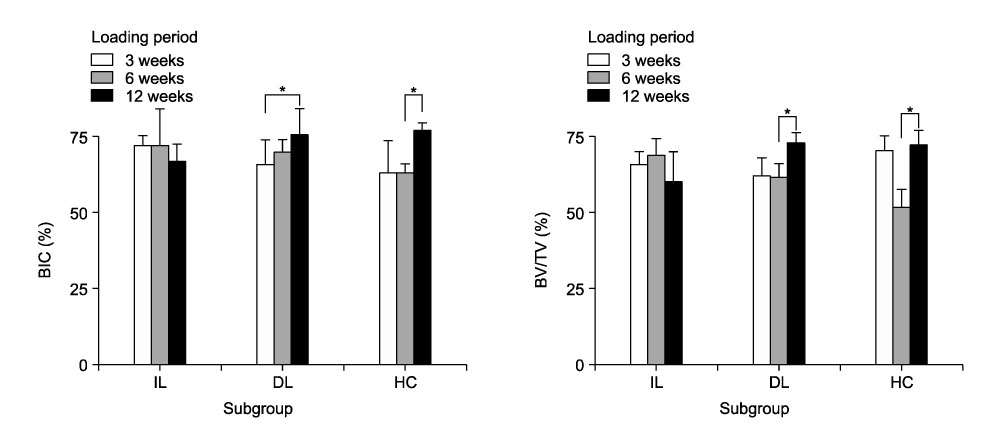The effect of loading time on the stability of mini-implant
- Affiliations
-
- 1Department of Orthodontics, College of Dentistry, Yonsei University, Korea.
- 2Department of Orthodontics, College of Dentistry, Dental Science Research Institute, Yonsei University, Korea. ypark@yuhs.ac.
- KMID: 1975904
- DOI: http://doi.org/10.4041/kjod.2008.38.3.149
Abstract
OBJECTIVE
The purpose of this study was to investigate the stability of mini-implants in relation to loading time. METHODS: A total of 48 mini-implants (ORLUS, Ortholution, Korea) were placed into the buccal alveolar bone of the mandible in 8 male beagle dogs. Orthodontic force (200 - 250 gm) was applied immediately for the immediate loading group while force application was delayed for 3 weeks in the delayed loading group. For the subsequent loading periods (3, 6, 12 weeks), BIC (bone implant contact) and BV/TV (bone volume/total volume) and mobility test were carried out. RESULTS: The immediate loading group showed no changes in BIC from 3 to 12 weeks, while the delayed loading group showed a significant increase in BIC between 3 and 12 weeks (p < 0.05). The BV/TV of the delayed loading group significantly increased from 6 to 12 weeks of loading (p < 0.05), while the BV/TV of the immediate loading group decreased from 3 to 12 weeks of loading. However, there was no significant difference in BV/TV between experimental groups. The mobility of the immediate loading group was not significantly different from that of the delayed loading group after 12 weeks of loading (p < 0.05). CONCLUSIONS: These results showed that immediate loading does not have a negative effect on the stability of mini-implants compared to the early loading method in both the clinical and histomorphometric point of view.
Figure
Cited by 3 articles
-
The effects of different pilot-drilling methods on the mechanical stability of a mini-implant system at placement and removal: a preliminary study
Il-Sik Cho, HyeRan Choo, Seong-Kyun Kim, Yun-Seob Shin, Duck-Su Kim, Seong-Hun Kim, Kyu-Rhim Chung, John C. Huang
Korean J Orthod. 2011;41(5):354-360. doi: 10.4041/kjod.2011.41.5.354.Histomorphometric evaluation of the bone surrounding orthodontic miniscrews according to their adjacent root proximity
Hyun-Ju Oh, Jung-Yul Cha, Hyung-Seog Yu, Chung-Ju Hwang
Korean J Orthod. 2018;48(5):283-291. doi: 10.4041/kjod.2018.48.5.283.Microimplant mandibular advancement (MiMA) therapy for the treatment of snoring and obstructive sleep apnea (OSA)
Joachim Ngiam, Hee-Moon Kyung
Korean J Orthod. 2010;40(2):115-126. doi: 10.4041/kjod.2010.40.2.115.
Reference
-
1. Kanomi R. Mini-implant for orthodontic anchorage. J Clin Orthod. 1997. 31:763–767.2. Park HS, Bae SM, Kyung HM, Sung JH. Micro-implant anchorage for treatment of skeletal Class I bialveolar protrusion. J Clin Orthod. 2001. 35:417–422.3. Kyung SH, Choi JH, Park YC. Miniscrew anchorage used to protract lower second molars into first molar extraction sites. J Clin Orthod. 2003. 37:575–579.4. Lee JS, Kim DH, Park YC, Kyung SH, Kim TK. The efficient use of midpalatal miniscrew implants. Angle Orthod. 2004. 74:711–714.5. Roth A, Yildirim M, Diedrich P. Forced eruption with microscrew anchorage for preprosthetic leveling of the gingival margin. Case report. J Orofac Orthop. 2004. 65:513–519.
Article6. Kyung SH, Choi HW, Kim KH, Park YC. Bonding orthodontic attachments to miniscrew heads. J Clin Orthod. 2005. 39:348–353. quiz 369.7. Park HS, Lee SK, Kwon OW. Group distal movement of teeth using microscrew implant anchorage. Angle Orthod. 2005. 75:602–609.8. Kim HJ, Yun HS, Park HD, Kim DH, Park YC. Soft-tissue and cortical-bone thickness at orthodontic implant sites. Am J Orthod Dentofacial Orthop. 2006. 130:177–182.
Article9. Turley PK, Kean C, Schur J, Stefanac J, Gray J, Hennes J, et al. Orthodontic force application to titanium endosseous implants. Angle Orthod. 1988. 58:151–162.10. Roberts WE, Helm FR, Marshall KJ, Gongloff RK. Rigid endosseous implants for orthodontic and orthopedic anchorage. Angle Orthod. 1989. 59:247–256.11. Wehrbein H, Diedrich P. Endosseous titanium implants during and after orthodontic load--an experimental study in the dog. Clin Oral Implants Res. 1993. 4:76–82.
Article12. Roberts WE, Nelson CL, Goodacre CJ. Rigid implant anchorage to close a mandibular first molar extraction site. J Clin Orthod. 1994. 28:693–704.13. Akin-Nergiz N, Nergiz I, Schulz A, Arpak N, Niedermeier W. Reactions of peri-implant tissues to continuous loading of osseointegrated implants. Am J Orthod Dentofacial Orthop. 1998. 114:292–298.
Article14. Melsen B, Costa A. Immediate loading of implants used for orthodontic anchorage. Clin Orthod Res. 2000. 3:23–28.
Article15. Deguchi T, Takano-Yamamoto T, Kanomi R, Hartsfield JK Jr, Roberts WE, Garetto LP. The use of small titanium screws for orthodontic anchorage. J Dent Res. 2003. 82:377–381.
Article16. Miyawaki S, Koyama I, Inoue M, Mishima K, Sugahara T, Takano-Yamamoto T. Factors associated with the stability of titanium screws placed in the posterior region for orthodontic anchorage. Am J Orthod Dentofacial Orthop. 2003. 124:373–378.
Article17. Cheng SJ, Tseng IY, Lee JJ, Kok SH. A prospective study of the risk factors associated with failure of mini-implants used for orthodontic anchorage. Int J Oral Maxillofac Implants. 2004. 19:100–106.18. Park HS, Jeong SH, Kwon OW. Factors affecting the clinical success of screw implants used as orthodontic anchorage. Am J Orthod Dentofacial Orthop. 2006. 130:18–25.
Article19. Park HS, Yen S, Jeoung SH. Histologic and biomechanical characteristics of orthodontic self-drilling and self-tapping microscrew implants. Korean J Orthod. 2006. 36:295–397.20. Kim JW, Ahn SJ, Chang YI. Histomorphometric and mechanical analyses of the drill-free screw as orthodontic anchorage. Am J Orthod Dentofacial Orthop. 2005. 128:190–194.
Article21. Frost HM. Perspectives: bone's mechanical usage windows. Bone Miner. 1992. 19:257–271.
Article22. Freire JN, Silva NR, Gil JN, Magini RS, Coelho PG. Histomorphologic and histomophometric evaluation of immediately and early loaded mini-implants for orthodontic anchorage. Am J Orthod Dentofacial Orthop. 2007. 131:704. e1-9.
Article23. Gray JB, Steen ME, King GJ, Clark AE. Studies on the efficacy of implants as orthodontic anchorage. Am J Orthod. 1983. 83:311–317.
Article24. Mori S, Burr DB. Increased intracortical remodeling following fatigue damage. Bone. 1993. 14:103–109.
Article25. Isidor F. Mobility assessment with the Periotest system in relation to histologic findings of oral implants. Int J Oral Maxillofac Implants. 1998. 13:377–383.26. Schulte W, Lukas D. The Periotest method. Int Dent J. 1992. 42:433–440.27. Tricio J, Laohapand P, van Steenberghe D, Quirynen M, Naert I. Mechanical state assessment of the implant-bone continuum: a better understanding of the Periotest method. Int J Oral Maxillofac Implants. 1995. 10:43–49.28. Trisi P, Rao W, Rebaudi A. A histometric comparison of smooth and rough titanium implants in human low-density jawbone. Int J Oral Maxillofac Implants. 1999. 14:689–698.29. Oyonarte R, Pilliar RM, Deporter D, Woodside DG. Peri-implant bone response to orthodontic loading: Part 2. Implant surface geometry and its effect on regional bone remodeling. Am J Orthod Dentofacial Orthop. 2005. 128:182–189.
Article
- Full Text Links
- Actions
-
Cited
- CITED
-
- Close
- Share
- Similar articles
-
- Analysis of time to failure of orthodontic mini-implants after insertion or loading
- Insertion and removal torques according to orthodontic mini-screw design
- Assessment of implant stability after immediate loading in dogs : clinical and radiographic study
- COMPARISON OF RESONANCE FREQUENCY ANALYSIS BETWEEN VARIOUS SURFACE PROPERTIES
- Mini-implant with additional retentive structure by using digital method






